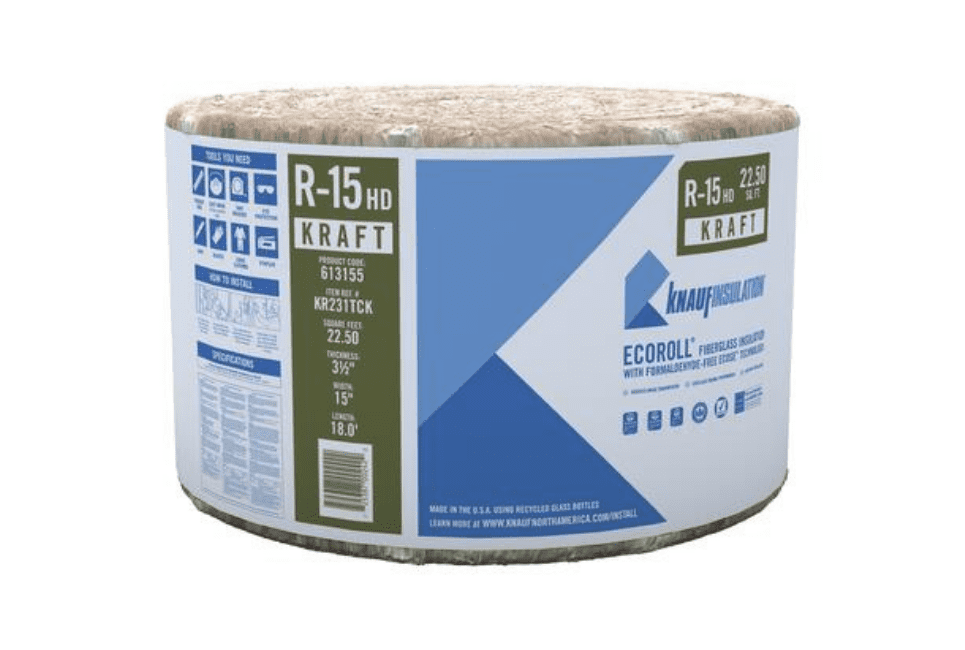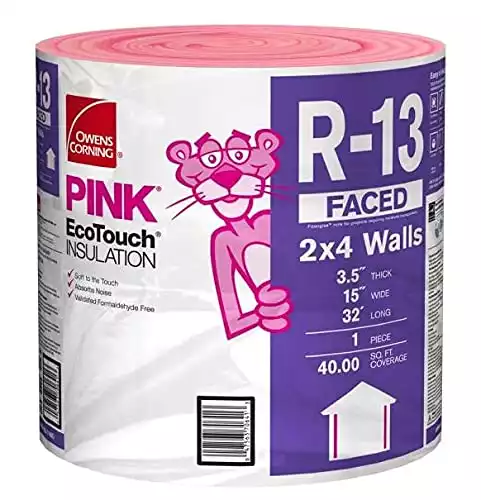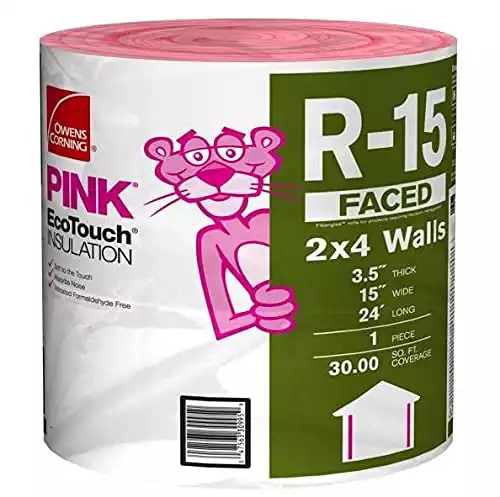The heat transfer ratio or the so-called R-value is the most important factor you must consider when selecting residential insulation for your home. Comparing the properties of R13 vs R15 insulation can be helpful if you’re not sure which one is the right choice for you.
You should also bear in mind that all types of insulation have R values, but the properties of fiberglass and mineral wool insulation materials are far from identical.
Hence, you shouldn’t base your search for the right insulation material solely on thermal resistance because some materials might cause respiratory issues while others might not be fire-resistant.
In this R13 Insulation vs R15 insulation comparison, we’ll look at their properties and provide you with the information you need to decide which one is the best option for you. Read our guide to ventilation systems to discover ways to improve the ventilation in your home.
Soft to the touch and easy to cut and install, Owens Corning insulation has a strong reputation with home builders for delivering the performance you can trust.
Main Differences Between R13 vs R15 Insulation
The main differences between R13 vs R15 Insulation are:
- R15 insulation has good thermal resistance, whereas the thermal resistance of the R13 insulation is slightly lower
- R13 insulation is affordable, whereas the R15 insulation is a more expensive option
- R15 insulation is commonly used in exterior walls, attics, and floors, whereas R13 insulation can be used in floors and exterior walls
- R13 insulation can block drafts in narrow spaces, whereas the R15 insulation is too bulky to fit in narrow spaces.
Despite these differences, R13 and R15 insulation have the same core features, which is why they’re often used interchangeably in walls with 2×4-inch wood studs. Go through our guide to heating systems to find the most energy-efficient heating method.

Examining the Features of R13 and R15 Insulation
R13 Insulation
Improve the comfort of your home with the exceptional thermal control, noise reduction and peace of mind of Owens Corning PINK Fiberglas insulation.
You can choose between faced and unfaced versions of R13 insulation depending on where you want to install it. Faced versions contain a retarder, a piece of paper that protects the insulation from soaking moisture.
You can increase the thermal resistance of the R13 insulation by stacking multiple layers of the same materials over each other. So, placing two rolls of R13 insulation on top of each other will enable you to create an insulation layer with R26 thermal resistance.
The R13 insulation materials are better suited for regions with relatively warm climates. You should search for materials with thermal resistance value over R30 if you live in a region with long and cold winters.
Also, you should either consider stacking multiple layers of this insulation or opting for a material with a higher R-value if you’re insulating a roof or an attic. Read our guide to furnace systems for more information about their heating capacities.
Key Features
The exact features of R13 insulation depend on the material, so it is hard to talk about a general set of features you can find on all R13 insulation models. However, fiberglass R13 insulation material is probably the most common version of R13 insulation you can find on the market.
However, its properties also vary from model to model, and some options are GREENGUARD Gold Certified, while others contain toxic particles that cause respiratory diseases. R13 cellulose insulation is the healthiest available option because it doesn’t contain noxious chemicals.
In terms of effectiveness and heat resistance, different insulation materials with R13 value offer the same level of heat protection. However, the R13 fiberglass batts are more affordable than mineral wool, cotton, or cellulose.
Browse through our guide to mini-split systems to help you regulate the room temperature in different parts of your home.
Heat Resistance
Aside from the R-value, you also need to pay attention to the U value while determining which insulation material you need. The U value shows you the thermal resistance of materials that constitute a specific building block, such as a wall or a roof.
This value isn’t the same for all building blocks, which is the reason why you have to use the insulation with a different R-value to insulate an exterior wall and an attic.

Also, you should consider the amount of sunlight a room is getting while trying to determine if R13 insulation material can provide it with sufficient heat protection. Broadly speaking, the R13 insulation is best suited for mild and moderate climates, and you can add it to exterior walls, basements, or floors.
Check out our guide to cooling systems to explore different whole-house cooling options.
Noise Absorption Potential
As a general rule, the more mass and density an insulation material has, the better it absorbs noises. For instance, R13 fiberglass batt insulation is 3-5/8-inches thick, while the same material with R40 value is approximately 12-inches thick.
This means that the noise absorption capacities of R13 insulation materials aren’t impressive, but they still dampen the outside noises. Also, it is worth adding that insulation materials can’t soundproof a space regardless of how thick they are.
Also, the sound absorption capacities of different R13 insulation materials aren’t the same, as R13 spray foam insulation is more effective at blocking noise than R13 fiberglass batts. You should check the home soundproofing standards in your state to know which insulation material you should get.
Go through our guide to fireplace systems if you’re considering this heating option.
Moisture Regulation Capacity
The thermal resistance of insulation material isn’t related to its ability to resist moisture. However, if an insulation material gets wet, its R-value will decrease. Opting for a faced R13 insulation material that contains a moisture barrier will prevent water in any shape or form from reaching the material.
Whether you should choose a faced or unfaced R13 insulation depends on where the material will be installed. So, if you’re insulating a roof, basement, or attic, the safer option would be to get the faced R13 insulation.
Given its relatively low heat resistance capacity, opting for insulation materials with R values higher than 13 might be a good backup if the material gets wet. Check out our guide to humidity control systems to explore different ways of controlling air humidity levels.
Home’s Energy Efficiency Level
Insulation materials don’t have energy efficiency ratings, and their heat resistance value indicates how efficient they are at blocking the cold or warm air from getting into your home.
There’s no doubt that any R13 insulation material can make your home more energy-efficient as they prevent the free flow of the outside air through the walls or floors.

Getting an insulation material with an R-value that is higher than 13 will increase the energy efficiency of your home, but doing so is often unnecessary and comes at a sizeable financial cost.
Read our guide to heat pumps to find out how these cooling and heating systems can make your home more energy-efficient.
R15 Insulation
Soft to the touch and easy to cut and install, Owens Corning insulation has a strong reputation with home builders for delivering the performance you can trust.
The performance capabilities of R13 and R15 materials are almost identical, despite the differences in their thermal resistance abilities. You can choose between faced and unfaced versions of R15 insulation, depending on your moisture protection needs.
Besides 2×4-inch walls, you can install R15 insulation materials on attics, basements, or floors with the same efficiency level. Creating a two-layer insulation structure with R15 materials enables you to double the heat resistance.
Although they’re not an ideal solution for homes located in regions with harsh winters, the R15 insulation materials are highly efficient in mild or warm weather conditions.
Their performance depends on the material, and you should opt for an R15 polystyrene or cellulose spray insulation if you want to reduce the heat transfer as much as possible. A fiberglass R15 insulation is a more affordable option that is less durable than its alternatives.
Key Features
You can’t know how well an insulation material will perform just by looking at its heat resistance capacities.
The lifespan of the R15 insulation you choose depends on its material, and you should aim for soy-based or mineral wool insulation if you want to get a material that doesn’t lose its properties over time. You should also check if the R15 insulation material you want to get is toxic.
The option you choose should be fire-resistant as the wall and floor insulation may prevent the fire from spreading through your home. R15 foam insulation materials are your worst option because they can catch fire at 300F.
It is worth adding that the features of R15 and R13 insulation materials are almost identical, but despite this, you should go through the specification list of both R13 and R15 models before you choose one or the other.

Heat Resistance
The heat resistance of R15 insulation is slightly larger than the heat resistance of R13 insulation. However, both options are suitable for 2×4-inch walls, and you should opt for an R19 insulation material if the walls in your home are 2×6-inches.
You should calculate the wall’s U value to determine if the R15 insulation is the right choice for it. Adding a layer of R5 or R10 insulation over an R15 material will enable you to extend the overall heat resistance to R20 or R25.
The R15 insulation material performs better in spaces that receive high amounts of sunlight than R13 insulation materials. Its heat resistance is sufficient to insulate attics, but you can only use it to insulate roofs if you create a multi-layer structure.
Noise Absorption Potential
The average width of R15 insulation material is between 3.5 and 4 inches. That’s why the noise dampening abilities depend on the properties of the material you choose.
The width of R13 and R15 insulation material is almost the same, and both options lower the volume of outside noises.
The noise absorption capacity of R15 insulation materials should be sufficient for most residential settings, but you’re going to need additional soundproofing if you want to record audio in your home.
You should find out more about the sound dampening abilities of different insulation materials in order to find the option that can block outside noises efficiently.
Moisture Regulation Capacity
Opting for a faced version of R15 insulation material will add an extra layer of protection against humidity. Moisture-resistant R15 insulation materials are also available, and they can be a great fit for spaces that are frequently exposed to water or high air humidity levels.
However, the R values don’t really affect the material’s ability to resist or control the amount of moisture that enters your home. Hence, the R13 and R15 insulation materials have the same moisture regulation capacity.
As we already noted, the R values of insulation materials decrease if they get wet, so opting for a model with a higher R-value might give you a slight advantage in case the water reaches the insulation material.
Home’s Energy Efficiency Level
The R15 insulation materials can lower the heat transfer rate more than R13 insulation. However, if used correctly, either option can increase your home’s energy efficiency level and reduce your monthly utility bills.
The ability of these materials to keep your home warm or cool also depends on where they’re installed, and you need to calculate if an R13 or R15 insulation is better for a particular room.
Besides the material’s heat resistance, numerous other factors can affect your decision to choose R15 or R13 insulation.
R13 vs R15 Insulation – Pros and Cons
R13 Insulation

Pros
- Suitable for insulating tight spaces
- Wide selection of materials
- Good sound absorption capabilities
- Affordable price
Cons
- It can’t be used to insulate roofs or attics
- Some R13 insulation materials aren’t fire resistant
R15 Insulation

Pros
- Excellent energy efficiency
- Waterproof versions of R15 insulation materials are available
- Helps with pest protection
- Great for exterior walls, attics, floors, and basements
Cons
- Some R15 insulation materials are difficult to install
- Only suitable for 2×4-inch walls
The Best Alternatives to R13 and R15 Insulation
You should base your choice of the insulation material and its R-value on careful calculation and not on rough estimates. The R-value range spans from 2 to 60, depending on the material and its properties.
So, if R13 or R15 insulation isn’t the right choice for you, you have to get the material with higher or lower R values. In addition to the heat resistance, you should pay attention to the material’s moisture and fire resistance capacities or its durability.
Let’s take a look at the properties of insulation materials with higher and lower R values than R13 or R15.
R11 Insulation
Kraft faced rolls - "Greenguard" certified LEED eligible. The Package Length of the product is 60.96 inches and the width is 63.5 inches.
The differences between R11, R13, and R15 insulation materials boil down to their heat resistance capacities. So, an R11 insulation material is less efficient at preventing the outdoor air from going through the walls than an R15 insulation material. Even so, either of these options can be installed on 2×4-inch walls.
The sound dampening, water, and fire resistance capacities of these materials aren’t affected by their R values, and you have to learn more about the properties of a particular material to determine if you can use it to insulate different parts of your home.
R19 Insulation
With less dust than other fiberglass products, EcoTouch PINK Fiberglass insulation has excellent stiffness and recovery characteristics.
The R19 and R21 insulation materials are commonly used to insulate 2×6-inch walls. They’re approximately 6-inches wide which is the reason why their soundproofing capabilities are better than those offered by R13 and R15 insulation.
Besides walls, the R19 insulation materials can be used to insulate floors or ceilings. Their performance in humid conditions depends on the material you choose, and you should consider waterproof models if you’re insulating a space with a high air humidity level.
R60 Insulation
Insulation materials with R values over 40 are best suited for roofs and attics. That’s why you should only consider an R60 insulation material if you’re looking to prevent heat transfer through the roof.
These materials are designed for cold climates, and you should opt for R50 or R48 insulation materials if you live in a region with a moderate or warm climate. The thickness of R60 insulation is around 17 inches, which enhances its sound dampening capacities.
The exact features of the R60 insulation depend on the material you choose.
Frequently Asked Questions About R13 and R15 Insulation
Question: Do R13 and R15 Insulation Materials Keep Insects Out?
Answer: Although the R13 and R15 insulation materials can prevent insects and rodents from entering your home through the walls, you still have to use other pest control options to keep ants, spiders, or mice away.
Question: How Long Do the R13 and R15 Insulation Last?
Answer: The fiberglass batts can start to lose their properties after 15 to 20 years, while other insulation materials can last up to a hundred years.
Question: Are all R13 and R15 Insulation Materials Fire-Resistant?
Answer: No, only some R13 and R15 insulation materials are fire-resistant, which is the reason why you need to check the temperature rating of the insulation material you want to get.
Question: How Much Does it Cost to Install the R13 and R15 Insulation?
Answer: The installation costs depend on the size of the area you want to insulate, and you can spend between $700 and $1,500 to insulate a 1,000sq/ft space.
Our verdict: Is the R13 Insulation Better than R15 Insulation?
The capacity of the R13 and R15 insulation to prevent heat transfer is almost the same. The R15 is a slightly better option because it is more efficient at preventing cold and hot air from flowing through the walls.
|
Primary Rating:
3.5
|
Primary Rating:
3.5
|
|
N/A
|
N/A
|
Nonetheless, using the R13 insulation won’t necessarily increase your cooling and heating costs, especially if the insulation material you choose is compatible with the U value of specific building blocks.
That’s why we recommend both R13 and R15 insulation materials if they’re suitable for the context in which you want to use them. Probably the best way to determine which option you should choose is to consult with a contractor that understands the needs of the space you want to insulate.
Was this R13 vs R15 comparison useful? Let us know in the comments, or continue reading our Goodman 3-ton heat pump review to find out how this cooling and heating system can help you control the temperature in your home.
- R13 vs R15 Insulation Compared: What’s the Difference? - December 9, 2023
- Ruud vs Trane HVAC Systems Compared - December 9, 2023
- Senville Mini Split Review and Guide: Is It Worth Buying? - December 9, 2023







